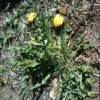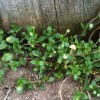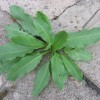There is a new link on this site for the First Wild Edible Walk of the season. Space is limited, so get your name on the list now! This is going to be surprising and fun! On April 13th we will be finding out what is emerging for a really tiny, yummy, nutrient rich salad. Don’t miss this one…or if you do, book me for your yard and neighborhood. Let’s see what we can find.
…And In Winter…
It’s hard to imagine wandering around looking for greens and fruits in this snowy weather. So I don’t. I’m relaxing with the knowledge that I have lots of fruits and veggies on the pantry shelves in the basement, a delicious reminder of the abundance of last summer and fall. There are still dried apples and apple sauce, dried apricots, canned apricots and apricot jam, dried plums, plum chutney and jam, and …well the same sorts of deliciousness with cherries, peaches, and pears. I love to gaze on three kinds of tomato sauce, quart jars filled with various colors of heirloom tomatoes, dilly beans and pickles.
Now is the time to use my dried ‘weeds’ and herbs to make oils and salves for healing. These little pots of green goodness are prized in my family for their amazing properties of healing chapped skin, rashes, rubs, minor burns, and scrapes. My Grandchildren ask for it when they have a “booboo”, and the youngest has to be watched like a hawk since she knows how to get the screw top off and uses it by the hand full in her hair! That’s how we found out it’s good for cradle cap, too. Best of all the ingredients are organic and/or wild crafted from plants that are also eaten, so if the little ones get it in their mouths, it won’t hurt them!
So, in part, that’s what an urban forager does during the Winter – other than wait for the first signs of Spring!
Berries and Cherries
If you are the type of person who loves to find really fresh fruits to pick, eat, and preserve for later, this is the time for berries and late cherries. What a great year it’s been for fruits! The mulberries were falling off the trees a few weeks ago, the cherries came next – both sour pie cherries and sweet black cherries. There are a few left, however it is becoming harder and harder to harvest them and then eliminate the little white worms eating around the pit. Everything loves cherries!!
I’m focusing on the huge crop of Saskatoons – also known as Juneberries, Serviceberries, and Shadbush. There botanical name is Amelanchier alnifolia, and they grow from Alaska to Colorado. In Denver they are used as an ornamental bush or tree, and they are getting ripe now! Looking like blueberries on a large bush or tree, (check out my video) they are best when cooked. I like to make jam or jelly, syrup, and use them in pie, muffins, or pancakes. This fruit was also used dried and mixed with dried meat and fat to make pemmican by the Native Americans.
Let me know if you have too many to pick and use or don’t want to bother. I’m still looking for sources of Elderberry and want flowers as well as berries. The flowers are out now (I think). Enjoy!!
Wild Edible Walk!
Next Saturday, June 23rd, there is a walk to look at and gather some edible neighborhood plants. We will meet in the backyard of People House, 3035 25th Ave at 9 am. There is a parking lot behind the building as on street parking is not always available. Come find out what you can eat and enjoy in most neighborhoods throughout Denver! $15.00 suggested donation and children are free if they bring a grown-up!
Sauteed Greens
With all the rain we’ve had, unusual for this time of year in Denver, the most delicious greens are available for the picking! A group of Urban Foragers joined me on Saturday to find out what was available to eat right now. We found so many delicious plants, we hardly left the backyard of People House at Federal and 25th Ave! Even though we found over a dozen different plants of interest, next month we’ll expand our search to another part of this neighborhood. I’d like to share a recipe with you for the greens you pick. Today I’m focusing on Dandelion Greens because you all know what they are, and they can even be bought at some grocery stores if you don’t have time to bend over and pick your own.
Sauteed Greens:
Saute chopped onion, garlic, and a hot dried pepper if you like until soft, add washed, chopped dandelion greens and any other greens you have on hand (Dock, kale, escarole, collard greens, etc). Stir them into the hot oil until wilted and bright green. Sprinkle with salt and pepper to taste and serve with a splash of your favorite vinegar. Enjoy!
the hot oil until wilted and bright green. Sprinkle with salt and pepper to taste and serve with a splash of your favorite vinegar. Enjoy!
If you want to know what wild edibles grow around your home, I can do a walk with you and your neighbors. Just contact me! I also love to take older school children, all sorts of groups, and gardeners who would rather eat the ‘weeds’ they pull than just throw them out!
Chickweed and Dock
This morning the light is so wonderful outside, I just had to go out and take some pictures of the greens available for our lunch and/or dinner! Keeping it simple is the ideal way to start, so I will only introduce you to two more of our green friends today.
 The first one is Chickweed. This little low growing plant is very tender and doesn’t last long here on the Front Range unless it gets regular moisture. So look for it where it is relatively sheltered and damp still during the Spring. If you were back East, it is sometimes considered a pest plant because it is so prolific. Not here, except in tiny moist eco-niches. It is too dry and in many places the soil is too sandy. Chickweed is a delicious little addition to a salad and some think it has a taste similar to beet greens. If there is a ‘bite’ to the plant, it is more on the lemony side, not bitter. All the aerial parts are edible after careful washing. It is also an amazing addition to salves for rashes and scrapes and you can just chew it a bit and put it right on a rash if you are outside and it is available.
The first one is Chickweed. This little low growing plant is very tender and doesn’t last long here on the Front Range unless it gets regular moisture. So look for it where it is relatively sheltered and damp still during the Spring. If you were back East, it is sometimes considered a pest plant because it is so prolific. Not here, except in tiny moist eco-niches. It is too dry and in many places the soil is too sandy. Chickweed is a delicious little addition to a salad and some think it has a taste similar to beet greens. If there is a ‘bite’ to the plant, it is more on the lemony side, not bitter. All the aerial parts are edible after careful washing. It is also an amazing addition to salves for rashes and scrapes and you can just chew it a bit and put it right on a rash if you are outside and it is available.
 My other yummy plant today is curly or yellow Dock. It is a fast growing plant that in some places has already put up a flower stalk. The leaves are quite spinach like and can be used as a quick cooking green. The ribs can be removed on the larger leaves or left on. They are a bit chewy but good. The leaves can also be used for roll-ups or wraps if you steam them for a minute to make them a little more flexible. Just cover one side of the leaf with filling and roll up! Delicious! Many people used to pick Dock on the way home from work to have fresh greens for supper. That’s still a good idea.
My other yummy plant today is curly or yellow Dock. It is a fast growing plant that in some places has already put up a flower stalk. The leaves are quite spinach like and can be used as a quick cooking green. The ribs can be removed on the larger leaves or left on. They are a bit chewy but good. The leaves can also be used for roll-ups or wraps if you steam them for a minute to make them a little more flexible. Just cover one side of the leaf with filling and roll up! Delicious! Many people used to pick Dock on the way home from work to have fresh greens for supper. That’s still a good idea.


